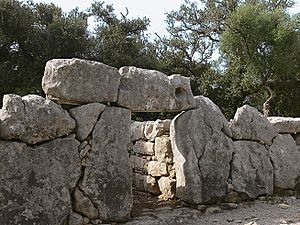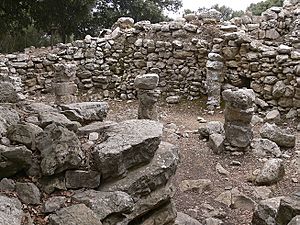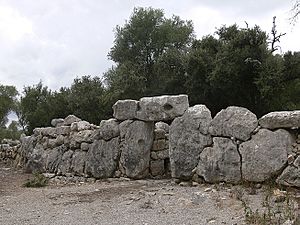Ses Païsses facts for kids
Ses Païsses is an ancient village from the Bronze Age on the edge of Artà in northeastern Majorca. It is one of the most important and best-kept prehistoric places in the Balearic Islands. Even though many trees like holm oaks cover it, you can still see how special this old settlement is.
Contents
What are Talaiots?
Talaiots are huge stone buildings from the Bronze Age found on the islands of Menorca and Majorca. There are at least 274 of these amazing structures. They were built between 1,300 and 900 BC.
These buildings are round or square. They are made of rough stones with a central space inside. A large column usually stood in the middle. This column held up a stone slab ceiling, which was also the floor for the next level.
People are not completely sure what talaiots were used for. Some ideas include places for religious events or tribal meetings. They might also have been storage areas or places to give out goods. Experts do not think they were homes or forts.
These talaiots were built before taulas, which are other large stone structures often found nearby. The Talaiotic Culture started about 3,000 years ago. It ended when the Romans arrived in the Balearic Islands in 123 BC.
How Ses Païsses Grew
The Ses Païsses village likely started with one round talaiot. This main tower was built around 900–800 BC. It was placed on a hill with a great view of the land around it. At first, it probably stood alone. It may have marked the edge of a territory.
This tower is 12 meters (about 39 feet) wide and still stands 4 meters (about 13 feet) tall. Inside its very thick wall, there are stairs. However, the big column in the center of the building is gone. Visitors cannot go inside this old building.
A low tunnel, about 0.75 meters (2.5 feet) high, goes through the building. It connects the main room to another room built later. This room is called the "hypostyle chamber" and is next to the talaiot on its northeast side.
The Hypostyle Chamber
The hypostyle chamber gets its name from the three short columns in its center. There are also parts of seven other columns built into its walls. This room has two straight walls, one square end, and one rounded end. It measures about 12 meters (39 feet) by 8 meters (26 feet).
Next to the hypostyle chamber, on the south side, is another rounded room shaped like a horseshoe. It is also connected to the central talaiot. This room was built after the main Talayotic period (between 500 and 123 BC).
Archaeologists dug up this room in 1959 and 1960. They found several fire pits with small pieces of bone, old pottery, and charcoal. They also found a burial and iron tools. This shows that people used the site even later in history.
The Great Outer Wall
Many kidney-shaped rooms have been found around the south side of the original talaiot. There are signs of other buildings in a central oval area. This area measures about 65 meters (213 feet) by 55 meters (180 feet) around the talaiot. More buildings are inside the huge outer wall of the settlement. This outer wall is also roughly oval. It measures about 140 meters (459 feet) by 105 meters (344 feet).
This very thick wall was built between 650 and 540 BC. This was long after the central talaiot and many buildings around it. The wall is made of "cyclopean masonry." This means it has a base row of huge outer boulders. Some of these stones weigh around 8 tons! Smaller stones were placed on top of them, but many are now scattered. The inside of the wall has rows of smaller rocks.
The outer wall is about 350 meters (1,148 feet) long. It seems to have had three entrances. The main gate is on the southeast side. It has two tall stones with a third stone balanced on top like a doorway. This gate opens into a passage 4.3 meters (14 feet) long with stairs on both sides.
Another entrance of similar size is to the northeast. Its top stone (lintel) is missing. The southwest gate also has no top stone. It is less easy to see and led to a nearby spring.
Other Cool Ancient Places
Here are some other important talayotic sites you might like to learn about:
- Capocorb Vell, 12 km (7.5 miles) south of Llucmajor: This is the most important Talayotic site on Majorca. It has five talaiots and an ancient village.
- Son Oleza dolmen, Majorca: This ancient stone tomb was found in 1999.
- Talatí de Dalt, Menorca
- Trebaluger, Menorca
- Trepucó, Menorca
- Torre d'en Galmés, Menorca
Other similar ancient structures, though not necessarily connected, include:
See also
 In Spanish: Ses Païsses de Artá para niños
In Spanish: Ses Païsses de Artá para niños
- Naveta These are boat-shaped stone buildings that are even older than the Talayotic culture.




